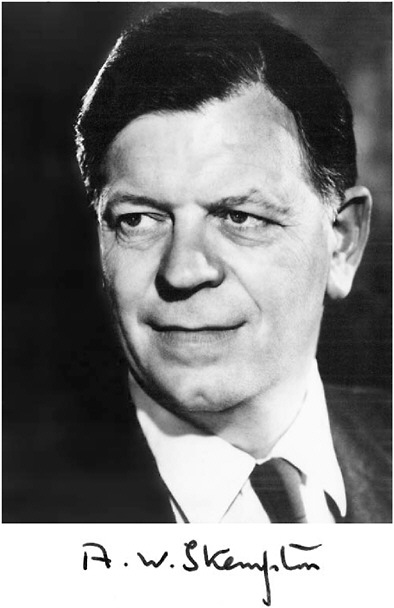ALEC W. SKEMPTON
1914–2001
Elected in 1976
“For leadership in the study and practice of geotechnical engineering.”
BY T. WILLIAM LAMBE
PROFESSOR ALEC W. SKEMPTON, one of the most influential British civil engineers of the 20th century and a world-renowned civil engineer, died on August 9, 2001, at the age of 87.
Alec studied civil engineering at Imperial College in London, where he developed an interest in geology and an ambition to conduct research. In 1937, he became interested in soil mechanics, the application of engineering science to geotechnical problems, when he participated in the investigation of the collapse of the embankment of the Chingford Reservoir, directed by Karl Terzaghi, the acknowledged “father” of soil mechanics.
Alec Skempton was an unusual man. An academic and scholar who considered research his first priority, he believed that firstrate research required an intimate association with practical engineering and real structures in the field. Not surprisingly, therefore, most of his research originated from problems that arose in the field, such as bearing capacity; slope stability; engineering geology; pore pressures and effective stresses in soil, rock, and concrete; and foundation engineering. His work on the fundamentals of soil mechanics and geotechnical engineering are still widely used as a basis for many design methods. For example, his work on settlements is the basis for current criteria for allow-
able settlements of structures. In addition, slopes in stiff clays are generally designed according to Alec’s methods.
Alec demonstrated a rare versatility—as scientist, engineer, historian, and musician. Through his writings and lectures, he had a major impact on geotechnical engineering around the world, and he won many awards and held many important positions—Rankine Lecturer, 1964; fellow of the Royal Society; and president of the International Society of Soil Mechanics and Foundation Engineering, 1957 through 1961.
In 2000, Alec was awarded a knighthood in the New Year’s Honors List for service to engineering. He was nominated by New Civil Engineering magazine as one of the greatest civil engineers of the 20th century.
Over the years, I corresponded and had personal contact with Alec Skempton from time to time. During my leadership of the Geotechnical Division at the Massachusetts Institute of Technology (MIT), I brought him to give lectures, and he proved to be the most popular lecturer I ever brought to MIT. In 1983, when I investigated the stability of a river bank at an industrial plant at Jarrow, England, I enlisted the assistance of Professor Peter Vaughan, a former student of Alec’s. When Alec heard of our investigation, he joined in purely out of interest in the problem.
Civil engineers around the world will mourn the passing of Alec Skempton.





